Effect of the Hole Diameter in Mechanical Properties of Wood: Experimental and Numerical Approaches
Abstract
:1. Introduction
2. Materials and Methods
2.1. Material Selection and Sampling
2.2. Mechanical Tests
2.3. Finite Element (FE) Model
2.4. Statistical Analysis of Experimental Data
3. Results and Discussion
3.1. Compression Parallel to Grain
3.2. Quasi-Static Bending Analysis
3.3. Tension Perpendicular to Grain
4. Conclusions
Author Contributions
Funding
Data Availability Statement
Acknowledgments
Conflicts of Interest
References
- Wimmers, G. Wood: A Construction Material for Tall Buildings. Nat. Rev. Mater. 2017, 2, 17051. [Google Scholar] [CrossRef]
- Qin, Y.; Dong, Y.; Li, J. Effect of Modification with Melamine–Urea–Formaldehyde Resin on the Properties of Eucalyptus and Poplar. J. Wood Chem. Technol. 2019, 39, 360–371. [Google Scholar] [CrossRef]
- Yoshihara, H.; Ataka, N.; Maruta, M. Analysis of the Open-Hole Compressive Strength of Spruce. Holzforschung 2016, 70, 449–455. [Google Scholar] [CrossRef]
- Yoshihara, H.; Maruta, M. Young’s Modulus and Shear Modulus of Open-Hole Spruce Measured by Vibration Tests. Wood Sci. Technol. 2019, 53, 1279–1294. [Google Scholar] [CrossRef]
- Reiner, J.; Pizarro, S.O.; Hadi, K.; Narain, D.; Zhang, P.; Jennings, M.; Subhani, M. Damage Resistance and Open-Hole Strength of Thin Veneer Laminates: Adopting Design and Testing Principles from Fibre-Reinforced Polymers. Eng. Fail. Anal. 2023, 143, 106880. [Google Scholar] [CrossRef]
- Mousavi, M.; Gandomi, A.H. Wood Hole-Damage Detection and Classification via Contact Ultrasonic Testing. Constr. Build. Mater. 2021, 307, 124999. [Google Scholar] [CrossRef]
- Chen, G.; Wu, J.; Jiang, H.; Zhou, T.; Li, X.; Yu, Y. Evaluation of OSB Webbed Laminated Bamboo Lumber Box-Shaped Joists with a Circular Web Hole. J. Build. Eng. 2020, 29, 101129. [Google Scholar] [CrossRef]
- Hallett, S.R.; Green, B.G.; Jiang, W.G.; Wisnom, M.R. An Experimental and Numerical Investigation into the Damage Mechanisms in Notched Composites. Compos. Part A Appl. Sci. Manuf. 2009, 40, 613–624. [Google Scholar] [CrossRef]
- Mascia, N.T. Análise de Tensões e Deslocamentos Em Peças Cilíndricas de Madeira Devido à Retração. Matéria 2015, 20, 32–46. [Google Scholar] [CrossRef]
- Mishnaevsky, L.; Qing, H. Micromechanical Modelling of Mechanical Behaviour and Strength of Wood: State-of-the-Art Review. Comput. Mater. Sci. 2008, 44, 363–370. [Google Scholar] [CrossRef]
- Sretenovic, A.; Müller, U.; Gindl, W.; Teischinger, A. New Shear Assay for the Simultaneous Determination of Shear Strength and Shear Modulus in Solid Wood: Finite Element Modeling and Experimental Results. Wood Fiber Sci. 2004, 36, 302–310. [Google Scholar]
- Yang, N.; Li, T.; Zhang, L. A Two-Dimensional Lattice Model for Simulating the Failure and Fracture Behavior of Wood. Wood Sci. Technol. 2020, 54, 63–87. [Google Scholar] [CrossRef]
- Aira, J.R.; Descamps, T.; Van Parys, L.; Léoskool, L. Study of Stress Distribution and Stress Concentration Factor in Notched Wood Pieces with Cohesive Surfaces. Eur. J. Wood Wood Prod. 2015, 73, 325–334. [Google Scholar] [CrossRef]
- ASTM D143-21; Standard Test Methods for Small Clear Specimens of Timber. ASTM International: West Conshohocken, PA, USA, 2023; p. 31. [CrossRef]
- Acosta, A.P.; de Avila Delucis, R.; Amico, S.C.; Gatto, D.A. Fast-Growing Pine Wood Modified by a Two-Step Treatment Based on Heating and in Situ Polymerization of Polystyrene. Constr. Build. Mater. 2021, 302, 124422. [Google Scholar] [CrossRef]
- Hein, P.R.G.; Chaix, G.; Clair, B.; Brancheriau, L.; Gril, J. Spatial Variation of Wood Density, Stiffness and Microfibril Angle along Eucalyptus Trunks Grown under Contrasting Growth Conditions. Trees Struct. Funct. 2016, 30, 871–882. [Google Scholar] [CrossRef]
- Moraisa, M.C.; Pereira, H. Heartwood and Sapwood Variation in Eucalyptus Globulus Labill. Trees at the End of Rotation for Pulpwood Production. Ann. For. Sci. 2007, 64, 665–671. [Google Scholar] [CrossRef]
- Svensson, S.; Toratti, T. Mechanical Response of Wood Perpendicular to Grain When Subjected to Changes of Humidity. Wood Sci. Technol. 2002, 36, 145–156. [Google Scholar] [CrossRef]
- Forest Products Laboratory. Wood Handbook: Wood as an Engineering Material; Forest Products Laboratory: Madison, WI, USA, 2010. [Google Scholar]
- Barbero, E.J. Introduction to Composite Materials Design; CRC Press: Boca Raton, FL, USA, 2010; ISBN 9780429109478. [Google Scholar]
- Acosta, A.P.; Beltrame, R.; Missio, A.L.; de Avila Delucis, R.; Gatto, D.A. Juvenile and Mature Woods from Pine Subjected to in Situ Polymerization with Furfuryl Alcohol. Wood Mater. Sci. Eng. 2020, 17, 151–156. [Google Scholar] [CrossRef]
- Mohebby, B.; Kevily, H.; Kazemi-Najafi, S. Oleothermal Modification of Fir Wood with a Combination of Soybean Oil and Maleic Anhydride and Its Effects on Physico-Mechanical Properties of Treated Wood. Wood Sci. Technol. 2014, 48, 797–809. [Google Scholar] [CrossRef]
- Tang, J.; Song, X.; Lu, Y. An Elastic-Plastic Kinking Layer Model for Parallel-to-Grain Wood Embedment Behavior Considering Wood Drilling Damage. Eng. Struct. 2023, 280, 115656. [Google Scholar] [CrossRef]
- Zangiácomo, A.L.; Christoforo, A.L.; Lahr, F.A.R. Módulo de Elasticidade Aparente Em Vigas Roliças Estruturais de Madeira Pinus Elliottii. Ambient. Construído 2014, 14, 7–13. [Google Scholar] [CrossRef]
- Crespo, J.; Majano-Majano, A.; Lara-Bocanegra, A.J.; Guaita, M. Mechanical Properties of Small Clear Specimens of Eucalyptus Globulus Labill. Materials 2020, 13, 906. [Google Scholar] [CrossRef] [PubMed]
- Andarini, R.D.; Raftery, G.M. Experimental Assessment of Self-Tapping Screws for the Reinforcement of Multiple Holes in Laminated Veneer Lumber Beams. Structures 2023, 57, 105275. [Google Scholar] [CrossRef]
- Wen, Y.; Yang, P.; Zhao, J.; Zhao, D. Theoretical and Experimental Considerations on the Neutral Axis of Wood Beams with a Hole in Different Locations. Holzforschung 2018, 72, 769–777. [Google Scholar] [CrossRef]
- Emaminasab, M.; Tarmian, A.; Pourtahmasi, K. Permeability of Poplar Normal Wood and Tension Wood Bioincised by Physisporinus Vitreus and Xylaria Longipes. Int. Biodeterior. Biodegrad. 2015, 105, 178–184. [Google Scholar] [CrossRef]
- Šebek, F.; Kubík, P.; Tippner, J.; Brabec, M. Orthotropic Elastic–Plastic–Damage Model of Beech Wood Based on Split Hopkinson Pressure and Tensile Bar Experiments. Int. J. Impact Eng. 2021, 157, 103975. [Google Scholar] [CrossRef]
- ABNT. Projeto de Estruturas de Madeira; Associação Brasileira de Normas Técnicas (ABNT): Rio de Janeiro, Brazil, 2022; Volume 81. [Google Scholar]
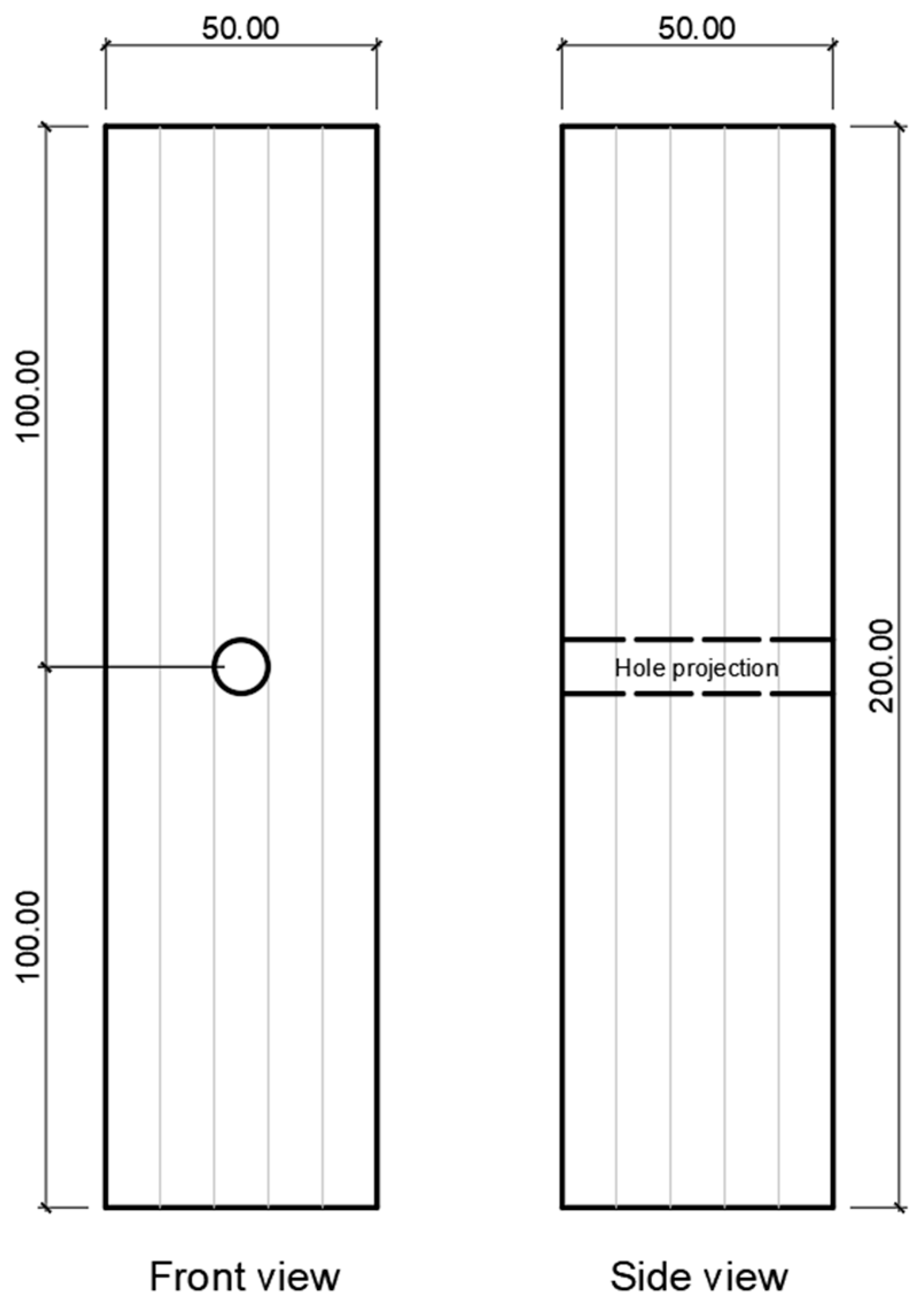

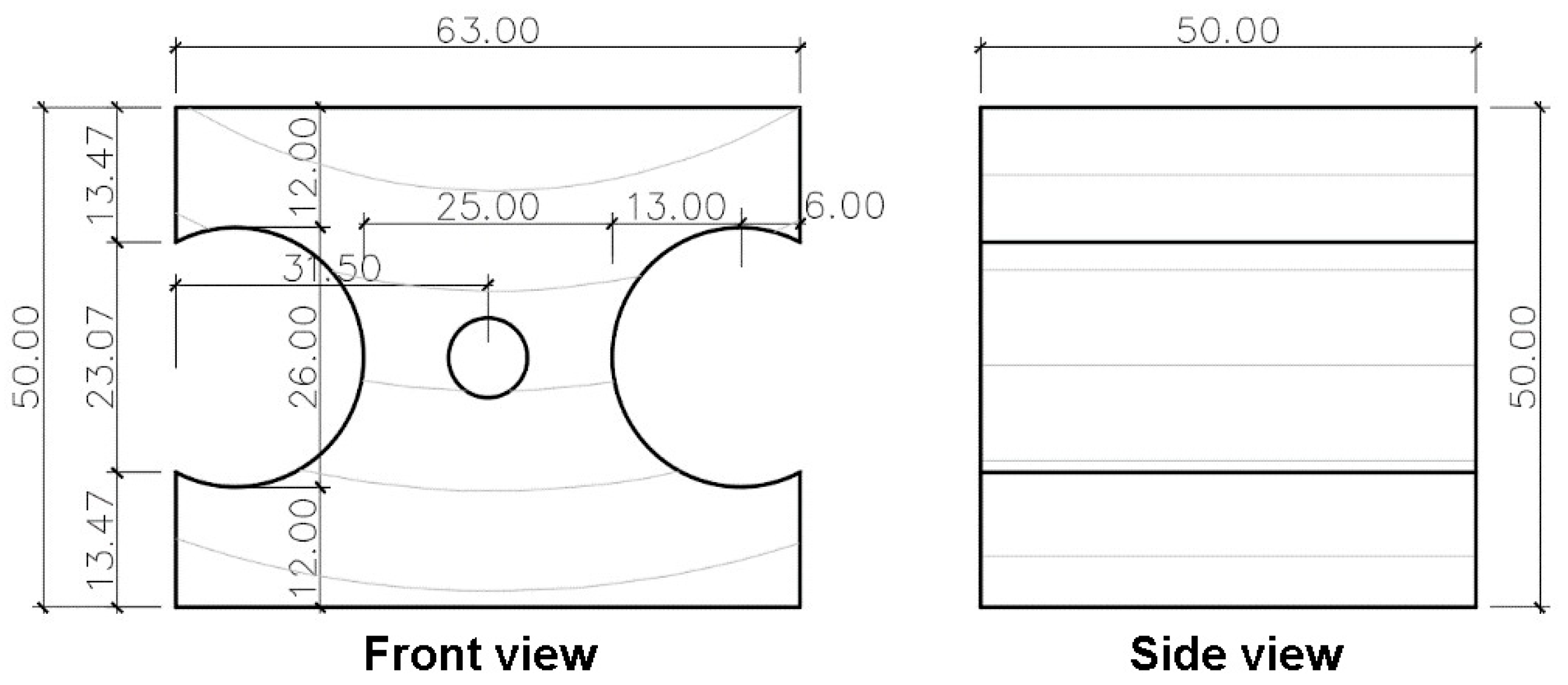

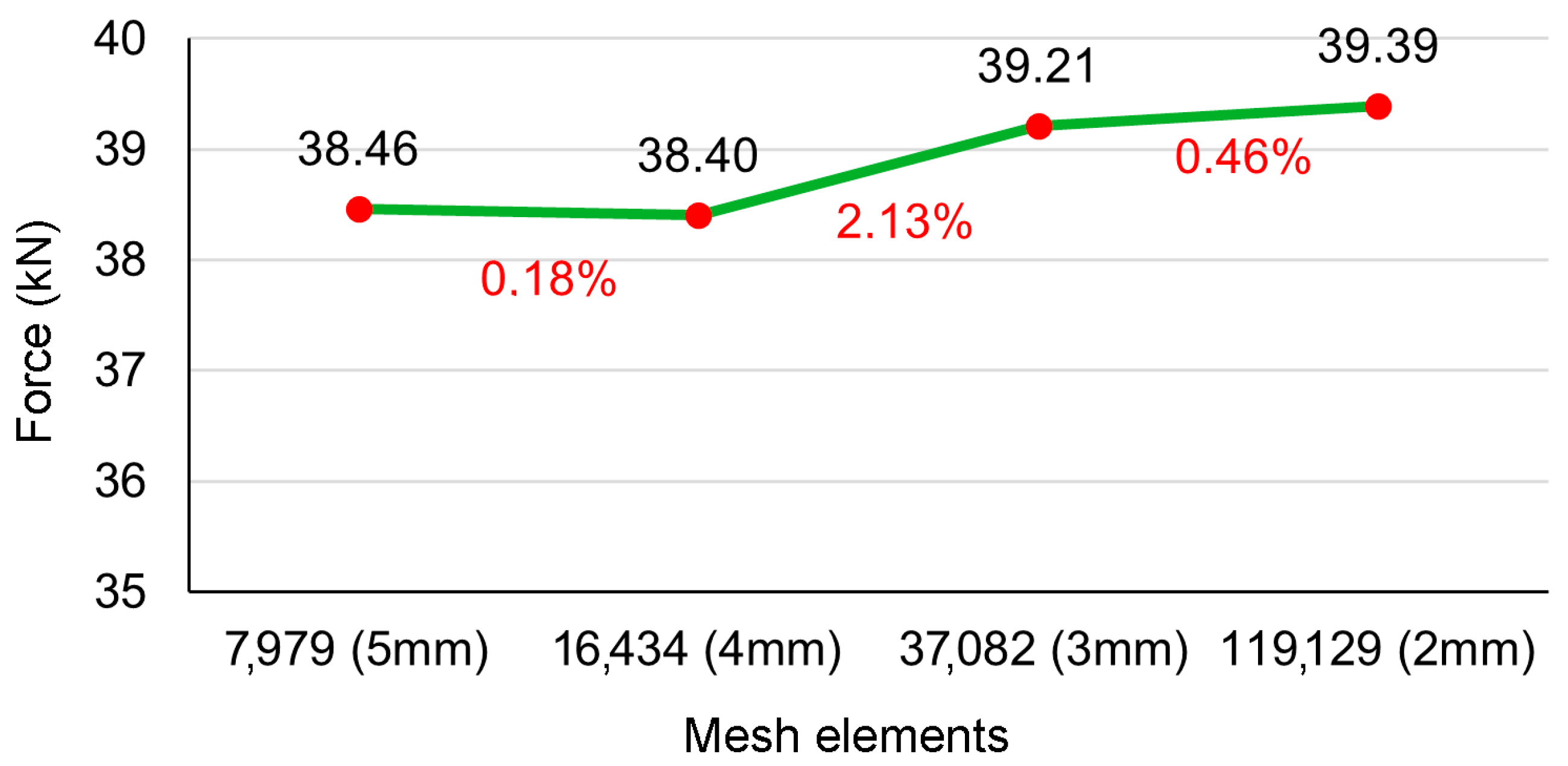
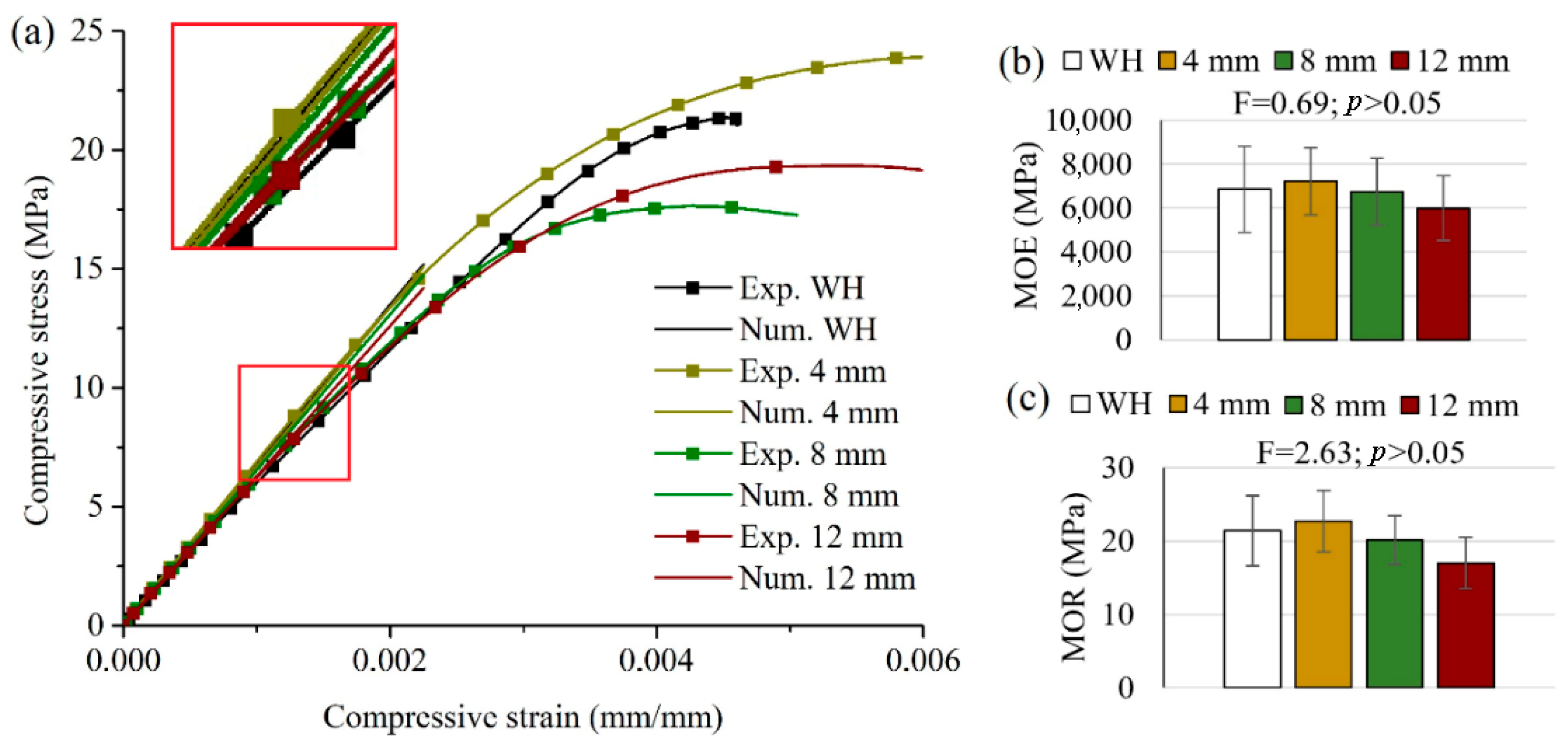
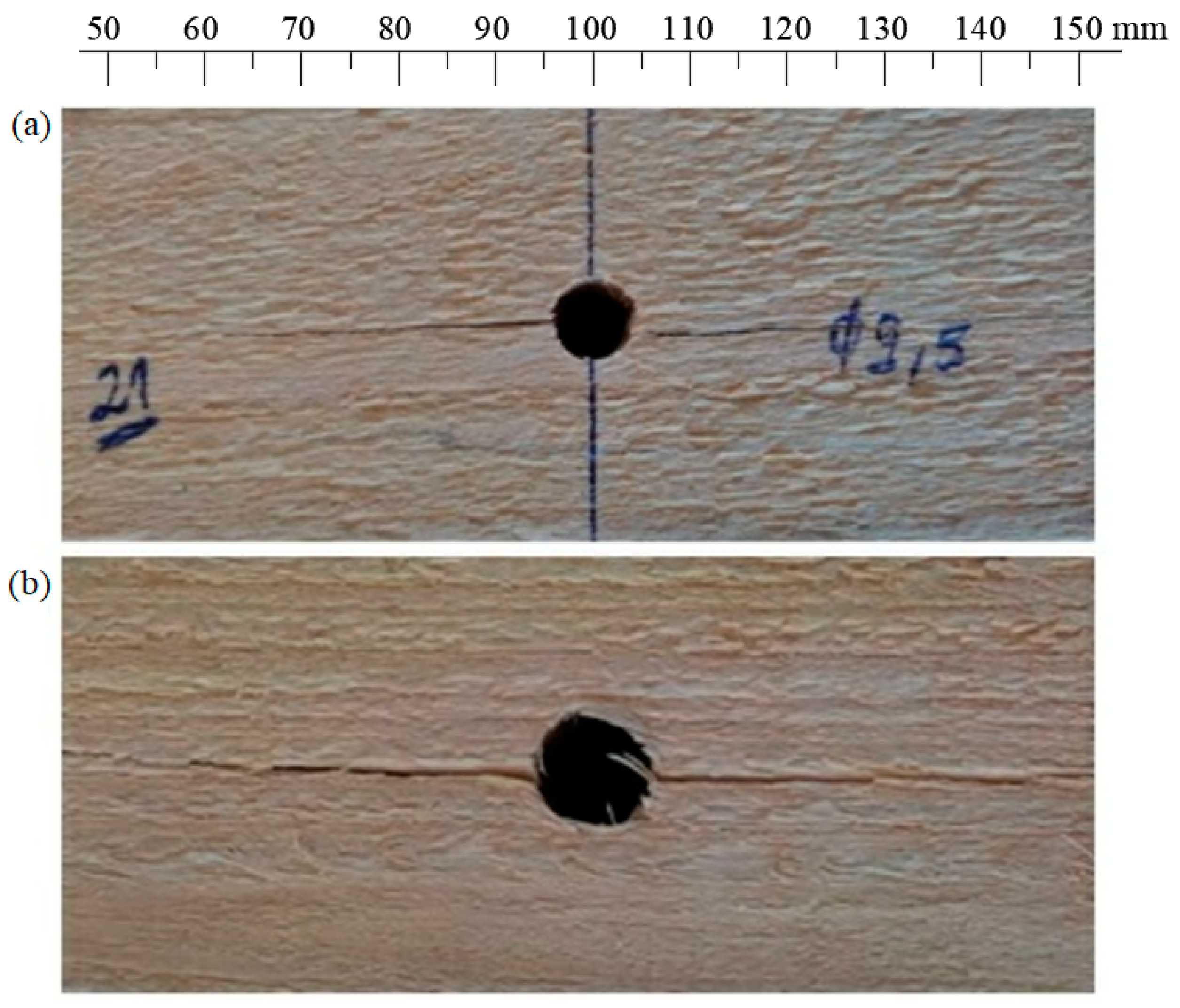
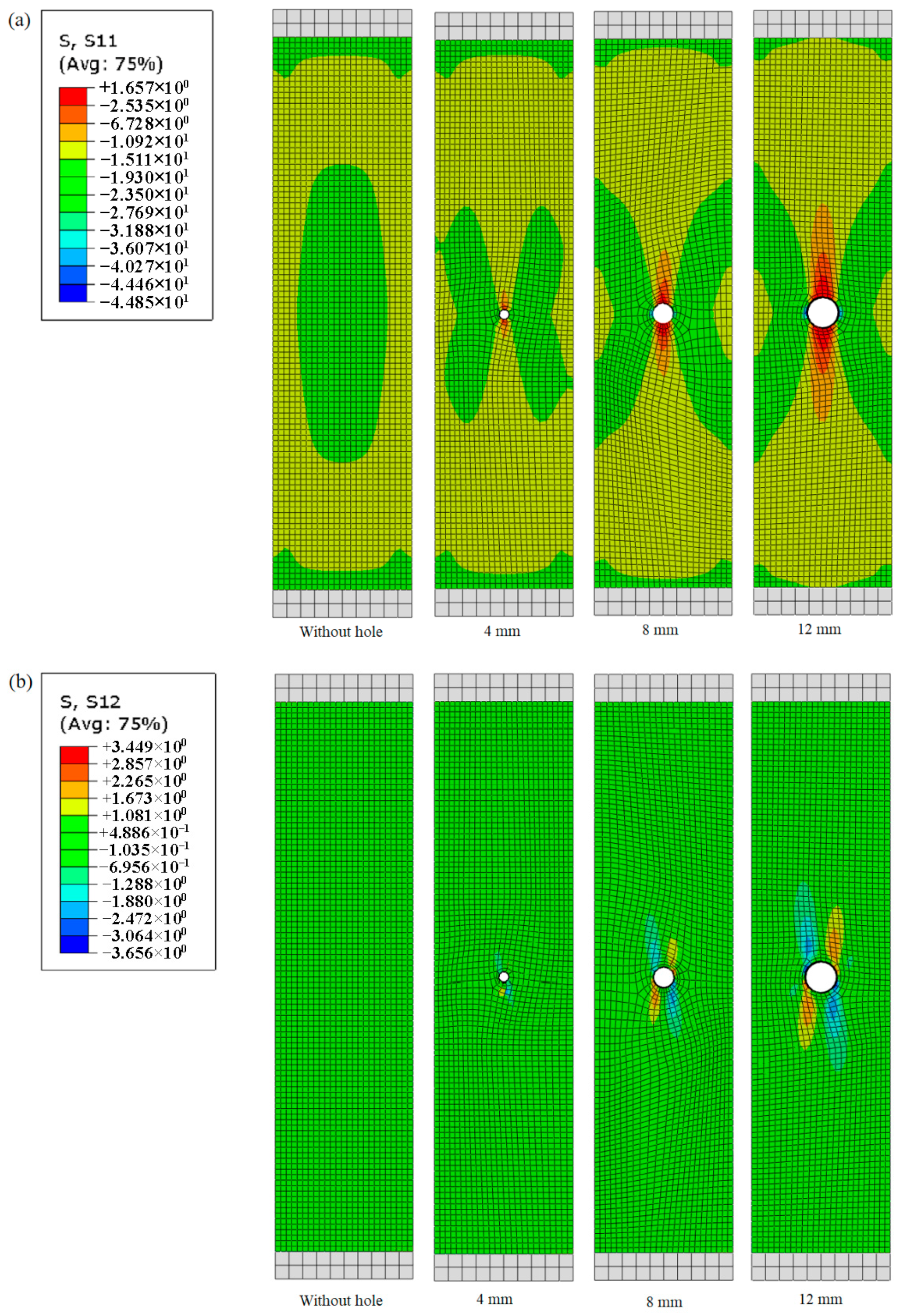


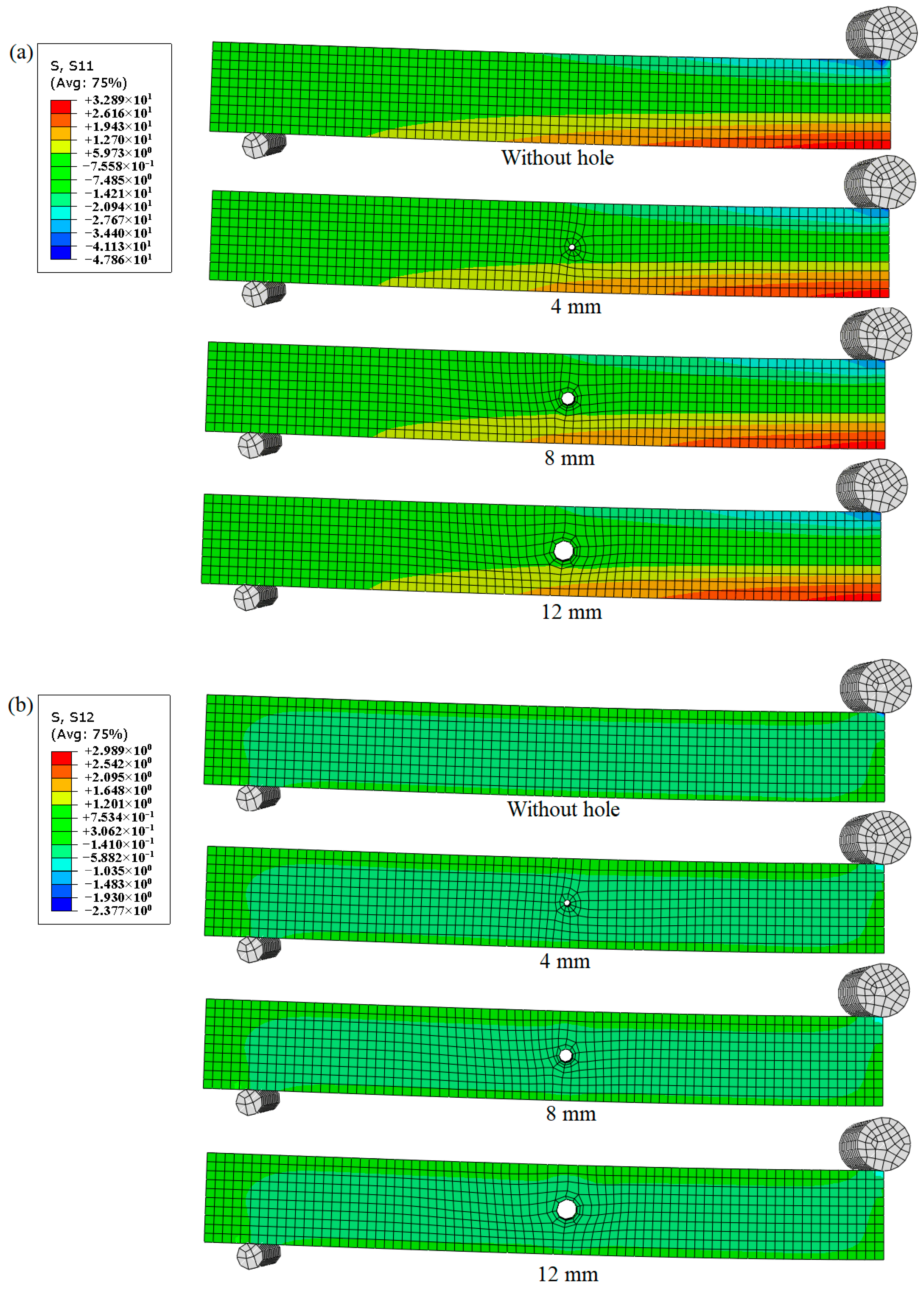


| * | |||||||||||
|---|---|---|---|---|---|---|---|---|---|---|---|
| 6848 | 308 | 507 | 0.444 | 0.020 | 0.392 | 0.029 | 0.387 | 0.636 | 363 | 377 | 68 |
| MPa | MPa | MPa | - | - | - | - | - | - | MPa | MPa | MPa |
| 7041.35 | 415.62 | 685.19 | 291.53 | 389.79 | 272.96 | 363.00 | 377.00 | 68.00 |
Disclaimer/Publisher’s Note: The statements, opinions and data contained in all publications are solely those of the individual author(s) and contributor(s) and not of MDPI and/or the editor(s). MDPI and/or the editor(s) disclaim responsibility for any injury to people or property resulting from any ideas, methods, instructions or products referred to in the content. |
© 2024 by the authors. Licensee MDPI, Basel, Switzerland. This article is an open access article distributed under the terms and conditions of the Creative Commons Attribution (CC BY) license (https://creativecommons.org/licenses/by/4.0/).
Share and Cite
Guidoti, A.B.; Aramburu, A.B.; Acosta, A.P.; Gatto, D.A.; Missio, A.L.; Beltrame, R.; Tonatto, M.L.P.; Delucis, R.A. Effect of the Hole Diameter in Mechanical Properties of Wood: Experimental and Numerical Approaches. Forests 2024, 15, 722. https://doi.org/10.3390/f15040722
Guidoti AB, Aramburu AB, Acosta AP, Gatto DA, Missio AL, Beltrame R, Tonatto MLP, Delucis RA. Effect of the Hole Diameter in Mechanical Properties of Wood: Experimental and Numerical Approaches. Forests. 2024; 15(4):722. https://doi.org/10.3390/f15040722
Chicago/Turabian StyleGuidoti, Arthur B., Arthur B. Aramburu, Andrey P. Acosta, Darci A. Gatto, André L. Missio, Rafael Beltrame, Maikson L. P. Tonatto, and Rafael A. Delucis. 2024. "Effect of the Hole Diameter in Mechanical Properties of Wood: Experimental and Numerical Approaches" Forests 15, no. 4: 722. https://doi.org/10.3390/f15040722







